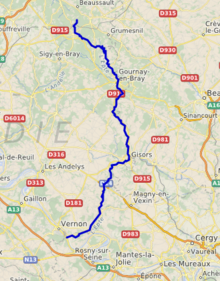Our website is made possible by displaying online advertisements to our visitors.
Please consider supporting us by disabling your ad blocker.
Epte
This article needs additional citations for verification. (May 2023) |
| Epte | |
|---|---|
 Claude Monet's 1899 The Waterlily Pond, green harmony. Monet's Water Lilies series was created and inspired by diverting a branch of the Epte to a section of his gardens. | |
 | |
| Location | |
| Country | France |
| Physical characteristics | |
| Source | |
| • location | Normandy |
| • elevation | 190 m (620 ft) |
| Mouth | |
• location | Seine |
• coordinates | 49°3′40″N 1°31′42″E / 49.06111°N 1.52833°E |
| Length | 112.5 km (69.9 mi) |
| Basin size | 1,403 km2 (542 sq mi) |
| Discharge | |
| • average | 9.8 m3/s (350 cu ft/s) |
| Basin features | |
| Progression | Seine→ English Channel |
The Epte (French pronunciation: [ɛpt]) is a river in Seine-Maritime and Eure, in Normandy, France. It is a right tributary of the Seine, 112.5 km (69.9 mi) long.[1] The river rises in Seine-Maritime in the Pays de Bray, near Forges-les-Eaux. The river empties into the Seine not far from Giverny. One of its tributaries is the Aubette de Magny.
In 911 the Treaty of Saint-Clair-sur-Epte established the river as the historical boundary of Normandy and Île-de-France.
Claude Monet lived at Giverny near the river for more than forty years.[citation needed] In his garden, by diverting a branch of the Epte, he established a water garden with its famous water-lily pond and its Japanese-style bridge. The river appears in a number of his works, including Peupliers au bord de l'Epte.
Previous Page Next Page


